
The Bergisches Land is a low mountain range in the state of North Rhine-Westphalia, Germany, east of the Rhine and south of the Ruhr. The landscape is shaped by forests, meadows, rivers and creeks and contains over twenty artificial lakes. Wuppertal is the biggest town, while the southern part has economic and socio-cultural ties to Cologne. Wuppertal and the neighbouring cities of Remscheid and Solingen form the Bergisches Städtedreieck.
The Oberbergischer Kreis is a Kreis (district) in the state of North Rhine-Westphalia, Germany. Neighboring districts are Ennepe-Ruhr, Märkischer Kreis, Olpe, Altenkirchen, Rhein-Sieg, Rheinisch-Bergischer Kreis, and the urban districts Remscheid and Wuppertal.

Nümbrecht is a municipality in the Oberbergischer Kreis, in North Rhine-Westphalia, Germany. It is a health resort, known for its good climate.
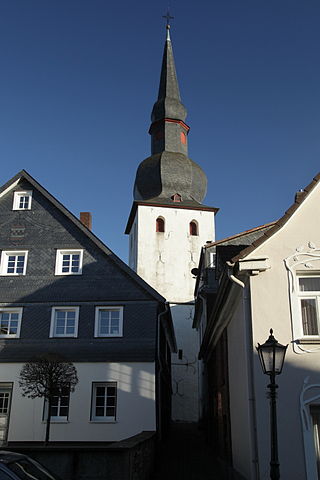
Bergneustadt is a municipality in the eastern part of the Oberbergischer Kreis (district), in North Rhine-Westphalia, Germany. It is located 50 km east of Cologne. It is part of the Berg region.
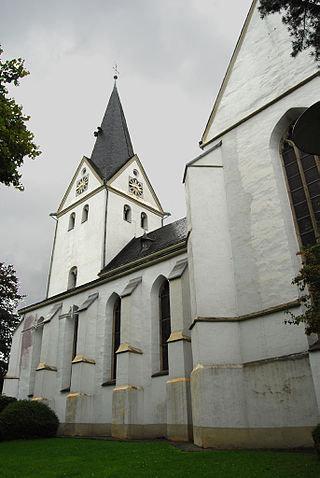
Gummersbach is a town in the state of North Rhine-Westphalia, Germany, being the district seat of the Oberbergischer Kreis. It is located 50 kilometres (31 mi) east of Cologne.
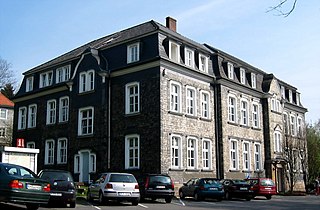
Waldbröl is a town in the southern part of the Oberbergischer Kreis, in North Rhine-Westphalia, Germany.
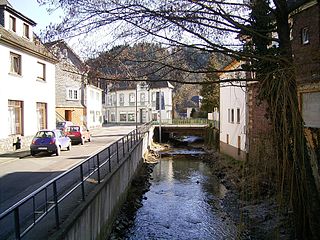
Morsbach is a municipality in Oberbergischer Kreis, a district in North Rhine-Westphalia near the border of Rhineland-Palatinate in Germany. In 2015, Morsbach's population was 10,600. The central village, also named Morsbach, has a population of 3,400. With a number of buildings dating back to the 12th century, it is a popular spot for hikers and other nature lovers.

Lindlar is a municipality in the Oberbergischer Kreis, in North Rhine-Westphalia, Germany. It is located about 30 km east of Cologne.
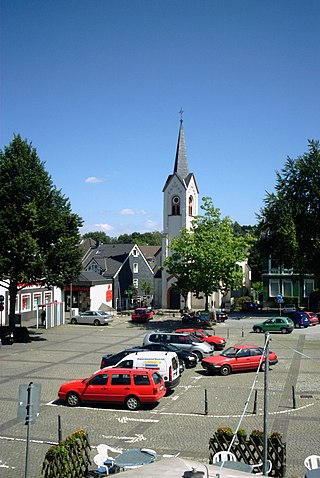
Wipperfürth is a municipality in the Oberbergischer Kreis of North Rhine-Westphalia, Germany, about 40 km north-east of Cologne, and the oldest town in the Bergischen Land.

Schmallenberg is a town and a climatic health resort in the High Sauerland District, Germany. By area, it is the third biggest of all cities and towns of the state of North Rhine-Westphalia and the second biggest of the region of Westphalia.
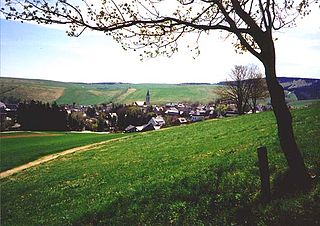
Oberwiesenthal is a town and a ski resort in the district of Erzgebirgskreis in Saxony in Germany. It is situated in the Ore Mountains, on the border with the Czech Republic, 19 km south of Annaberg-Buchholz, and 23 km northeast of Karlovy Vary. At 914 metres (2,999 ft), it is the highest town in Germany. The Olympic and World Championships goldmedalist in ski jumping Jens Weißflog competed for SC Tractor Oberwiesenthal and Oberwiesenthaler SV.

Nieder-Wiesen is an Ortsgemeinde – a municipality belonging to a Verbandsgemeinde, a kind of collective municipality – in the Alzey-Worms district in Rhineland-Palatinate, Germany.

The Siegburg–Olpe railway or Agger Valley Railway is a single-tracked, non-electrified branch line in the German state of North Rhine-Westphalia. Part of a direct link from Cologne, only the section from Overath to Gummersbach-Dieringhausen is still in operation. The section of line from Siegburg to Overath and from Dieringhausen to Olpe are closed.
The Cologne–Overath railway is a single-track, non-electrified railway in the German state of North Rhine-Westphalia. It was opened in 1910 to connect the historic Siegburg–Olpe railway directly to Cologne and required the construction of the Hoffnungsthal tunnel. The section from Hoffnungsthal to Rösrath partly used the track of the Cologne–Lindlar railway, which is now largely disused west of Bergisch Gladbach. The line, like the Siegburg–Olpe line, is also called the Aggertalbahn, although it leaves the valley of the Agger not far from Overath.

Gummersbach-Dieringhausen station has existed since 1887 and it made the formerly insignificant village of Dieringhausen an important regional town in the German state of North Rhine-Westphalia. Its former railway lines, railway depot and railway settlements still dot the village.
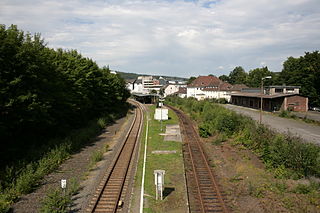
Gummersbach station is on the Hagen–Dieringhausen railway and serves central Gummersbach in the Oberbergische district. Until the 1980s, Dieringhausen station, which is also in Gummersbach, was more important for the city as it had a rail workshop and was a railway junction. Gummersbach station only became more important with the closing of branch lines in the Oberbergische district and the associated loss of significance for Dieringhausen.
Sondern is a small village approximately 6 kilometres (3.7 mi) the north of Radevormwald, in Oberbergischer Kreis district, North Rhine-Westphalia, Germany. It lies to the south of Remlingrade, and close to Birken, Im Kamp, and Herkingrade. Politically the village is represented by candidates of the electoral district 170 of the Radevormwald city Council. Around the year 1400 the village was mentioned as "Sunderen" in documents of the archives of the Reformed church in Radevormwald in connection with the description of the boundaries of the Free Court of Radevormwald at the time.

Adele Zay was a Transylvanian teacher, feminist and pedagogue. Her family were part of the German-speaking community of the Kingdom of Hungary. Because of her father's death during her infancy, Zay's education was interrupted by periods where she taught to earn money in order to continue private and formal studies. In 1880 after studying abroad in Vienna and Gotha, she passed her primary education certification for Germany and Hungary. The following year, she was certified as a secondary teacher, becoming the first Transylvanian woman to have earned a higher education. From 1875 to 1884, she taught at the Institute of Irma Keméndy in Szeged.

Michaela Barbara Engelmeier is a German politician (SPD). She was a member of the German Bundestag from 2013 to 2017. She is a former member of the German national women's judo team. From 2020 to 2022, she was the first Secretary General of the German-Israeli Society. Since September 2022, she has been chairwoman of the board of SoVD.
























